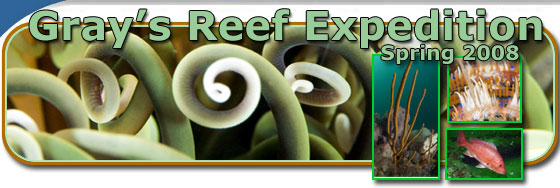Error processing SSI file
|
Mission Log: May 14, 2008
NOAA Ship Nancy Foster
By Beth McGovern, Kathryn Kornberg and Steve Desper
Whew! What a day! We have all been quite busy aboard the R/V Nancy Foster. The day began for most with breakfast at 0700. (Around here, nobody misses a meal…more on that tomorrow.)
At 0800 we arrived at the site where the two chevron traps were dropped yesterday afternoon. The first Zodiac (NF 3) launched with Coxswain Sarah Mrozek, NOAA divers, Marc Monaco, Matt Kendall, and Laurie Bauer, accompanied by Scott Noakes, from the University of Georgia. Their first task was to examine the traps to be sure they landed in the right spot and to check them for fish. The traps successfully landed next to a ledge, but unfortunately held only black sea bass. The target species, scamp grouper and red snapper successfully avoided being caught. Scamp grouper were seen in the area, but seemed to be observing the traps from a safe distance. Smart fish!
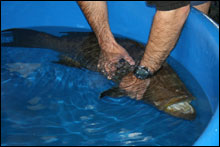 |
|
Scamp grouper being acclimated to holding tank.
|
Why are these researchers interested in trapping snapper and groupers? So they can tag them of course! Matt, Laurie, and Marc are scientists with the NOAA Center for Coastal Monitoring and Assessment Biogeography Team. They are utilizing tiny sonic abdominal tags to answer questions about movement of scamp and red snapper throughout the reef. Tagged fish will emit signals captured by receivers resting on reef ledges. The receivers will be picked up every few months and analyzed to determine the fish’ movements. Do these large fish stay in one area of the reef or do they roam over larger areas? Does that make a difference? Absolutely. It's important to know where these fish spawn, where they spend time maturing, and then, as adults, where they fit into the population dynamics of the reef as a whole. The more scientists and resource managers know about a species, the better able they are to manage and protect the stock.
The 2nd task for the NOAA team this morning was to begin marine debris surveys. The purpose of this project is to determine the amount of debris accumulating annually at designated sites within Gray’s Reef. Additionally, comparisons will be made between high use and low use areas (based on boat traffic data). This morning, working in pairs, the divers laid a 50m transect line. They then surveyed 2m on either side of the line, to cover a total of 200 square meters. The area was checked for debris, which could include recreational fishing debris such as monofilament, hooks, lead weights, and trash such as bottles, rope, wood and cans. As expected, since it was within a low-use area, the site was clean. The transect stakes were left in place so the same site could be surveyed again within the year.
At 0830, NF 2 was deployed with Coxswain Gordan Pringle, Greg McFall, Research Coordinator at Gray’s Reef and the Georgia Southern University (GSU) team, Danny Gleason, Lauren Divine, and Kenan Matterson. Lauren and Kenan are graduate students new to Georgia Southern, so this dive was to serve as their checkout dive. They returned to the Foster after a successful checkout dive to recharge their tanks for an afternoon working dive.
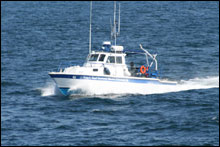 |
|
Arrival of the Gray's Reef Research Vessel Joe Ferguson.
|
At 1000, the R/V Joe Ferguson arrived with our VIPs’ for the day, Dick and Karen Utzinger from Savannah’s Skidaway Island. The Utzingers’ visit to the Foster was a dream that came true for Karen, a writer, who as a child wanted to become a marine biologist. Dick, a retired investment manager, was thrilled to make the trip and knew it was not an option to leave his wife at home. They both had a marvelous time touring the ship with Operations Officer LT Sarah Mrozek. After the ship’s tour they spent the rest of the day with Sarah Fangman (Associate Regional Science Coordinator, National Marine Sanctuaries, Southeast, Gulf of Mexico and Caribbean) and Cathy Sakas (Gray’s Reef Education Coordinator), meeting the scientific crew and the ship’s crew and observing the day’s operations. The Utzingers summed up their experience, “it takes a lot of money, time and personnel to accomplish the work of ocean research and exploration and we’ve only just begun!” They concluded that this work is critical in understanding the largest of our planet’s features, our ocean.
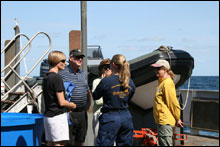 |
|
Sarah, Sarah and Cathy briefing the Utzingers about the operations being conducted aboard Nancy Foster.
|
After the Ferguson successfully delivered the Utzingers to the Foster, the crew of the Ferguson began relentless hook and line sampling for scamp grouper. Fortunately, hook and line sampling was far more successful than the chevron traps and the crew of the Ferguson delivered three large scamp grouper to Matt and Marc, aboard the Foster. The fish were quickly placed into an aerated holding tank to acclimate prior to surgery.
At 1300 the second Zodiac, NF2, was deployed with Coxswain Ben Nolan, Greg McFall, and the Georgia Southern dive group. Since 2004 Danny Gleason and his students have been evaluating benthic invertebrates at J-Reef, located north of the sanctuary (see abstracts). Gleason is the lead author of A Guide to the Benthic Invertebrates and Cryptic Fishes of Gray’s Reef. This online identification key provides information and photographs for many species at Gray’s Reef.
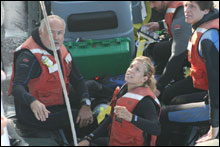 |
|
Divers returning to Nancy Foster to tie up after diving.
|
On this trip they will be scouting locations for permanent monitoring sites that are similar to the sites that have previously been studied at J-Reef. In addition to looking for permanent site locations, they will be comparing the invertebrate populations of varying elevations within the sanctuary. Today’s dive was an opportunity for Kenan and Lauren, who are new to the project, to prepare for their upcoming research tasks by familiarizing themselves with identifying the species of interest while diving. They were able to identify several of the invertebrate species of interest and also saw sea jellies, a green sea turtle, and remora, which incidentally attached itself to Lauren’s head.
At 1700 while most of us ate yet another yummy meal, the three scamp grouper were successfully tagged. Late in the afternoon, Matt and Marc, assisted by Greg, surgically implanted sonic transmitters into the abdominal cavity of each fish. The fish were returned to the holding tank to recuperate and will be released in the morning.
And while the majority of the Foster crew is fast asleep, another group of scientists, technicians, and students hover over computers in the dry laboratory while the ship steams back and forth over a pre-determined section of the ocean bottom - much like mowing a lawn. The senior scientist on this project is Greg McFall, and the survey technicians are Missy Partyka and Melody Ovaro. They are using sound waves to map the ocean bottom. A multi-beam sonar unit mounted on the bow of the ship sends sound waves to the bottom where they are reflected back to sensors and sent to an array of computers for analysis. These signals are translated into actual depth soundings which are then produced as false color images of the ocean bottom. The scientists are interested in learning whether there are other reef structures near Gray's Reef. Research has shown that the reef structures are more likely to be high-activity habitats where fish, invertebrates, and marine plants will likely be more abundant.
|

